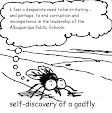despite two fatal flaws.
The first, is its ease of readability which can be objectively measured, and is far beyond the overwhelming majority of its "readers".
The second, is that it begins with a weasel clause.
"Nothing in the following is intended to prevent a ...principal or other administrator from using his/her best judgment with respect to a particular situation."Within "the following", you will find the Minimum Mandatory Consequences for students who choose to break the rules.
The Minimum Mandatory Consequences are what a teacher relies upon when they need to convince a student that there are consequences for misconduct that are inescapable. It is where the rubber meets the road.
There is a tension in the APS, between teachers and administrators over the enforcement of discipline polices. I think it is fair to say that, in general, teachers believe that principals do not impose harsh enough consequences on students who deliberately and chronically misbehave.
When a principal fails to impose a minimum mandatory consequence; let's say because the kid has parents who are both lawyers; s/he cannot be held accountable for failing to follow the handbook; because it contains a weasel clause.
"Best judgement" is a very slippery slope. Best judgement does not require explanation or defense. It is not subject to review. It is what it is; best judgement.
The weasel clause makes the entire document meaningless; unenforceable on those who are charged with its enforcement.
There is a need for command decision making. There is no need for command decision making that is not subject to review.
The only reason to insist upon the prerogative of making command decisions without review, is to evade accountability for bad command decisions.

No comments:
Post a Comment